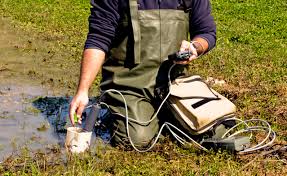Occurrence, Molecular Characterisation and Antibiogram of Water Quality Indicator Bacteria (Pseudomonas Aeruginosa and Enterobacter Aerogenes) in Water Samples from Klang River

Abstract:
Background and Objectives: Klang River is a 120 km long extremely polluted
river with 11 major tributaries. The pollution is due to the areas where the water
passes through. The aims of this research were to identify multidrug resistant Pseudomonas
aeruginosa and Enterobacter aerogenes, phenotypically identify their resistance
induced traits, and to determine the molecular characterisation of these strains.
Methods: In this research, 30 water samples were collected
from different sites along Klang River, their physical properties and biological
oxygen demand were estimated. The gram negative multidrug resistant (MDR) strains
were isolated, Hodge test, Double Disk Synergy Test and Disk Potentiation Test were
done to identify the cause of their resistance induced
traits, and plasmid DNA profiling was carried out.
Results: One multidrug resistant (MDR) P. aeruginosa strain was isolated from the
30 samples, it was a non-carbapenemase and metallo-β-lactamase (MBL) producing strain.
9 E. aerogenes carbapenemase and MBL producing strains were identified, 6 of them
were MDR, after extracting the bacteria plasmid DNA, it was confirmed that the bacteria were
within the same range as that of control bacterium (marker).
Conclusion: Multidrug resistant P. aeruginosa and E. aerogenes
were present in the water samples and they had similarly sized DNA fragments to
control bacterium.
Keywords: Pseudomonas aeruginosa; Enterobacter
aerogenes; multidrug resistance; metallo-β-lactamase.
References:
[1].
Lockhart, S., Abramson,
M., Beekmann, S., Gallagher, G., Riedel, S., Diekema, D., Quinn, J. and Doern, G.
(2007). Antimicrobial Resistance among Gram-Negative Bacilli Causing Infections
in Intensive Care Unit Patients in the United States between 1993 and 2004. Journal
of Clinical Microbiology, 45(10), pp.3352-3359.
[2].
Hidron, A., Edwards,
J., Patel, J., Horan, T., Sievert, D., Pollock, D. and Fridkin, S. (2008). NHSN
Annual Update: Antimicrobial‐Resistant Pathogens Associated with Healthcare‐Associated
Infections: Annual Summary of Data Reported to the National Healthcare Safety Network
at the Centers for Disease Control and Prevention, 2006–2007 •. Infection Control
and Hospital Epidemiology, 29(11), pp.996-1011.
[3].
Thiolas, A., Bollet, C., La Scola, B., Raoult,
D. and Pages, J. (2005). Successive Emergence of Enterobacter aerogenes Strains
Resistant to Imipenem and Colistin in a Patient. Antimicrobial Agents and Chemotherapy,
49(4), pp.1354-1358.
[4].
Mallea, M., Chevalier,
J., Bornet, C., Eyraud, A., Davin-Regli, A., Bollet, C. and Pages, J. (1998). Porin
alteration and active efflux: two in vivo drug resistance strategies used by Enterobacter
aerogenes. Microbiology, 144(11), pp.3003-3009.
[5].
Jana, S., Trivedi,
M. and Branton, A. (2015). Characterization of Phenotype and Genotype of Biofield
Treated Enterobacter aerogenes. Translational Medicine, 05(04).
[6].
Hallin, M., Deplano,
A., Roisin, S., Boyart, V., De Ryck, R., Nonhoff, C., Byl, B., Glupczynski, Y. and
Denis, O. (2012). Pseudo-Outbreak of Extremely Drug-Resistant Pseudomonas aeruginosa
Urinary Tract Infections Due to Contamination of an Automated Urine Analyzer. Journal
of Clinical Microbiology, 50(3), pp.580-582.
[7].
Adesoji, A., Ogunjobi,
A. and Olatoye, I. (2015). Molecular characterization of selected multidrug resistant
Pseudomonas from water distribution systems in southwestern Nigeria. Annals of
Clinical Microbiology and Antimicrobials, 14(1).
[8]. Mena KD and Gerba CP (2009). Risk assessment of Pseudomonas
aeruginosa in water. Reviews of Environmental
Contamination and Toxicology, 201, pp.71-115.
[9].
Craun , G., Calderon,
R. and Craun, M. (2005). Outbreaks associated with recreational water in the United
States. International Journal of Environmental Health Research, 15(4), pp.243-262.
[10].
Fontes, L., Neves,
P., Oliveira, S., Silva, K., Hachich, E., Sato, M. and Lincopan, N. (2011). Isolation
of Pseudomonas aeruginosa Coproducing Metallo- -Lactamase SPM-1 and 16S rRNA Methylase
RmtD1 in an Urban River. Antimicrobial Agents and Chemotherapy, 55(6), pp.3063-3064.
[12].
Pitout, J., Gregson,
D., Poirel, L., McClure, J., Le, P. and Church, D. (2005). Detection of Pseudomonas
aeruginosa Producing Metallo Lactamases in a Large Centralized Laboratory. Journal
of Clinical Microbiology, 43(7), pp.3129-3135.
[13]. Mena KD and Gerba CP (2009). Risk assessment of Pseudomonas
aeruginosa in water. Reviews of Environmental
Contamination and Toxicology, 201, pp.71-115.
[14].
Ranjan, S., Sreenivasa
Babu, P. and Banashankari, G. (2014). Comparison of epidemiological and antibiotic
susceptibility pattern of metallo-beta-lactamase-positive and metallo-beta-lactamase-negative
strains of pseudomonas aeruginosa. Journal of Laboratory Physicians, 6(2),
p.109.
[15].
Corcoran, E., Nellemann,
C., Baker, E., Bos, R., Osborn, D. and Savelli, H. (2010). Sick water? The central
role of wastewater management in sustainable development. 1st ed. Arendal: UNEP/GRID-Arendal.
[16].
Ventola, C. L. (2015).
The Antibiotic Resistance Crisis: Part 1:
Causes and Threats. Pharmacy and Therapeutics, Pharmacy and Therapeutics, 40(4), 277–283.
[17].
Fawell, J. (2003).
Contaminants in drinking water. British Medical Bulletin, 68(1), pp.199-208.
[18].
Artemova, T., Gerardin,
Y., Dudley, C., Vega, N. and Gore, J. (2015). Isolated cell behavior drives the
evolution of antibiotic resistance. Molecular Systems Biology, 11(7), pp.822-823.
[19]. Hussain, M. and Rao, T. (2013). Effect of Industrial Effluents
on Surface Water Quality - A Case Study of Patancheru, Andhra Pradesh, India. Current
World Environment Journal, 8(3), pp.445-454.
[20].
Coutinho, F., Silveira,
C., Pinto, L., Salloto, G., Cardoso, A., Martins, O., Vieira, R. and Clementino,
M. (2014). Antibiotic Resistance is Widespread in Urban Aquatic Environments of
Rio de Janeiro, Brazil. Microbial Ecology, 68(3), pp.441-452.
[21].
Okokwo
Iheanyi, Damilola,
Adejoye Oluseyi; Adeola, Ogunnusi Tolulope; A, Enobong; B, Shittu
Olufunke. (2008). Microbiological and physicochemical analysis
of different water samples used for domestic purposes in Abeokuta and Ojota, Lagos
State, Nigeria. African Journal of
Biotechnology, pp. 617-621.
[22].
Carpenter, J. (1965).
THE CHESAPEAKE BAY INSTITUTE TECHNIQUE FOR THE WINKLER DISSOLVED OXYGEN METHOD.
Limnology and Oceanography, 10(1), pp.141-143.
[23].
Slekovec, C., Plantin,
J., Cholley, P., Thouverez, M., Talon, D., Bertrand, X. and Hocquet, D. (2012).
Tracking Down Antibiotic-Resistant Pseudomonas
aeruginosa Isolates in a Wastewater Network. PLoS ONE, 7(12), p.e49300.
[24]. Cappuccino, J. and Sherman, N. (2007). Microbiology: A Laboratory
Manual. 8th ed.
[25]. CLSI Institute 2011
[26].
Bashir D, Thokar MA, Fomda
BA, Bashir G, Zahoor D, Ahmad S, Toboli AS (2011). Detection of metallo-beta-lactamase
(MBL) producing Pseudomonas aeruginosa at a tertiary care hospital in Kashmir. Afr.
J. Microbiol. Res. 5(2):164-172.
[27]. Jorgensen, J. and Turnidge, J. (2015). Susceptibility Test Methods:
Dilution and Disk Diffusion Methods*. Manual of Clinical Microbiology, 11th Edition,
pp.1253-1273.
[28]. Amjad, A., Mirza, I., Abbasi, S., Farwa, U., Malik, N., &
Zia, F. (2011). Modified Hodge test: A simple and effective test for detection of
carbapenemase production. Iranian Journal of Microbiology, 3(4), pp.189–193.
[29]. Sowmya,
G., Shivappa, Ranjitha Shankaregowda, Raghavendra Rao M, Rajeshwari K G, Madhuri
Kulkarni (2015). Detection of Metallo-beta lactamase production in clinical isolates
of Nonfermentative Gram negative bacilli. IOSR Journal of Dental and Medical Sciences
(IOSR-JDMS), pp. 43-48.
[30]. Canhoto, O. and Magan, N. (2005). Electronic nose technology
for the detection of microbial and chemical contamination of potable water. Sensors
and Actuators B: Chemical, 106(1), pp.3-6.
[31].
Khajuria, A., Praharaj,
A., Kumar, M. and Grover, N. (2014). Carbapenem Resistance among Enterobacter Species
in a Tertiary Care Hospital in Central India. Chemotherapy Research and Practice,
2014, pp.1-6.
[32]. Nasreen, M., Sarker, A., Malek, M., Ansaruzzaman, M. and Rahman,
M. (2015). Prevalence and Resistance Pattern of Pseudomonas aeruginosa isolated from Surface Water. Advances in Microbiology,
05(01), pp.74-81.
[33]. Bhalerao
DS, Roushani S, Kinikar AG, Akhter I. (2010). Study of Metallo-beta lactamase producing
Pseudomonas aeruginosa in Pravara Rural Hospital. Pravara Med Rev; 2(3).
[34]. Manoharan, A., Chatterjee, S., Mathai, D. and SARI Study Group
(2010). Detection and characterization of metallo beta lactamases producing Pseudomonas
aeruginosa. Indian Journal of Medical Microbiology, 28(3), p.241.
[35]. Kali, A. (2013). Detection of metallo-beta-lactamase producing
Pseudomonas aeruginosa in intensive care units. Australasian Medical Journal,
6(12), pp.686-693.
[36]. Qu TT1,
Zhang JL, Wang J, Tao J, Yu YS, Chen YG, Zhou JY, Li LJ. (2009). Evaluation of phenotypic
tests for detection of metallo-beta-lactamase-producing Pseudomonas aeruginosa strains in China. J Clin Microbiol 47(4): pp.1136-1142.
[37]. Jácome,
P., Alves, L., Cabral, A., Lopes, A. and Maciel, M. (2012). Phenotypic and molecular
characterization of antimicrobial resistance and virulence factors in Pseudomonas
aeruginosa clinical isolates from Recife, State of Pernambuco, Brazil. Revista
da Sociedade Brasileira de Medicina Tropical, 45(6), pp.707-712.
[38].
Lee, K., Lim, Y.,
Yong, D., Yum, J. and Chong, Y. (2003). Evaluation of the Hodge Test and the Imipenem-EDTA
Double-Disk Synergy Test for Differentiating Metallo- -Lactamase-Producing Isolates
of Pseudomonas spp. and Acinetobacter spp.
Journal of Clinical Microbiology, 41(10), pp.4623-4629.
[39]. Ataee
R. A., Tavana A. m., Hosseini S. M. J., Moridi K., and Zadegan M. G. (2012). A Method
for Antibiotic Suseptibility Testing: Applicable and Accurate. Jundishapur J Microbiol. 5(1), pp. 341-345.
[40]. Cox, B. (2003). A review of dissolved oxygen modelling techniques
for lowland rivers. The Science of The Total Environment, 314-316, pp.303-334.
[41]. Diene, S., Merhej, V., Henry, M., El Filali, A., Roux, V., Robert,
C., Azza, S., Gavory, F., Barbe, V., La Scola, B., Raoult, D. and Rolain, J. (2012).
The Rhizome of the Multidrug-Resistant Enterobacter aerogenes Genome Reveals How
New “Killer Bugs” Are Created because of a Sympatric Lifestyle. Molecular Biology
and Evolution, 30(2), pp.369-383.37.

